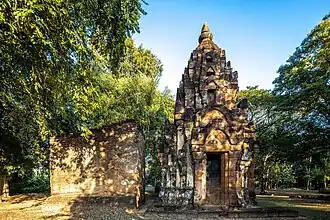Wat Chao Chan
| Wat Chao Chan (Si Satchanalai Historical Park) | |
|---|---|
 Wat Chao Chan in December 2023 | |
| General information | |
| Status | Active heritage site |
| Type | Abandoned historical site |
| Architectural style | Lopburi art (Bayon style) |
| Town or city | Si Satchanalai Subdistrict, Si Satchanalai District, Sukhothai Province |
| Country | |
| Coordinates | 17°31′39″N 99°45′53″E / 17.5275°N 99.7646°E |
| Completed | Around the 18th Buddhist century |
| Owner | Fine Arts Department |
| Technical details | |
| Material | Laterite coated with stucco |
| Known for | Central prang |
Wat Chao Chan (วัดเจ้าจันทร์) is an abandoned historic temple located within the ancient city of Chaliang in Si Satchanalai Subdistrict, Si Satchanalai District, Sukhothai Province, Thailand.
Location
Wat Chao Chan lies within the Si Satchanalai Historical Park, on the eastern side of the Yom River, close to the main cluster of monuments in the ancient city of Chaliang. It can be accessed via local roads from the main entrance of the historical park, and is a short walk from other Khmer-style temples such as Wat Si Sawai. The site is set in a gardened archaeological zone managed by the Fine Arts Department.
History
No specific records of its construction exist, but the use of laterite as the primary material allows comparison with religious monuments built during the reign of Jayavarman VII, suggesting that it was likely built in this period.
Wat Chao Chan is mentioned in King Vajiravudh's royal travelogue Tiew Mueang Phra Ruang (“Travels in the Land of Phra Ruang”):
"In the same direction as Wat Mahathat there is another place called Wat Chao Chan, reached through villagers' banana gardens. At the site there is a prang with a base measuring 3 wah square and about 6 wah high. One can enter inside the prang. As soon as I saw it, I exclaimed that it was a Hindu sanctuary or Brahmin temple, the prang style being clear evidence—similar in design to Wat Si Sawai or Wat Phra Phai Luang in Sukhothai. While rummaging through piles of fallen stones, bricks, and mortar, I happened to find a discarded head of the Hindu god Shiva, carved in stone, with an urna as identifying mark."
Architecture and Antiquities
The main structure is a central prang in Khmer style, built of large laterite blocks coated with stucco. The main sanctuary has niches on all four sides, with the only real entrance to the east; the other sides feature false doors. In front of the prang is a small chamber for an image, and the superstructure tapers like a lotus bud with decorative stucco finials.
In the Sukhothai period, the site was converted into a Buddhist temple. The base of the prang was partially buried, covering the mouldings, and a laterite vihara was constructed in front of it, along with a laterite mondop to the north housing a standing Phra Attharot image. Inside the mondop is the laterite core of a standing Buddha image with hands close to the body.[2]
Excavations by the Fine Arts Department uncovered Buddha amulets cast in lead-tin alloy depicting a crowned Buddha in royal attire. Deeper layers revealed Dvaravati period artifacts, Hariphunchai ceramics, glass beads, and human skeletal remains.[3]
References
- ^ "Wat Chao Chan". Si Satchanalai Historical Park, Sukhothai.
- ^ "Wat Chao Chan". Ministry of Tourism and Sports of Thailand.
- ^ "Prasat Wat Chao Chan". Southeast Asian Arts Database.